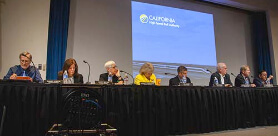CEO Report – April 2020
 The March Board of Directors meeting was canceled due to the COVID-19 pandemic. Because of that, this CEO Report also covers developments that occurred in late February and March.
The March Board of Directors meeting was canceled due to the COVID-19 pandemic. Because of that, this CEO Report also covers developments that occurred in late February and March.
We Are Conducting Business at the Authority During COVID-19
Along with the state and the nation, the Authority has been adapting to and addressing the evolving circumstances associated with the COVID-19 pandemic. The health and safety of the public and our employees is our highest priority. We continue to take our lead from the Governor’s Office and public health officials and as the situation changes, we continue to adapt. At this point in time, I can report the following:
Authority Staff are Effectively Teleworking: More than 90 percent of the organization is now teleworking on a full-time, part-time or rotational basis. We have extended the use of the Emergency Telework Program beyond the original April 17th date to essentially “until further notice.” Embracing telework is the primary way to implement the physical distancing policy that is so important in the fight against COVID-19. I am pleased with how quickly and efficiently our team made the transition.
Using Technology to Conduct Business: We have embraced technological options to execute our work, and this April Board of Directors meeting is evidence of that. We began shifting our external public meetings to a virtual format in March with open houses conducted in the Southern California region. For the foreseeable future, we will continue to utilize technology for external meetings, including public workshops and open houses. We are using best practices from our sister departments and the Administration to ensure we’re reaching as much of the public as possible; advancing our work and adhering to physical distancing policies. I want to commend our Strategic Communications, Multimedia and IT divisions for helping us make this transition so quickly and effectively.
Taking Steps to Maintain Construction Safety: Public works construction remains an essential function under the state guidelines and directives to date. At our construction sites, we continue to work with various unions, the State Building and Construction Trades, our contractors and construction management teams to implement best practices for safety at those job sites. We monitor and assess jobsite conditions every day, and we are fortunate to report that to date we have had no known confirmed cases of COVID-19 among the construction-site workers or our contractors. Unfortunately, our freight railroad partner did have a confirmed case, to which we responded appropriately and in conjunction with local public health officials to maintain safety.
The Work is Advancing During this Pandemic
Construction is Progressing in the Central Valley: Despite the COVID-19 challenges, we are seeing momentum build in Central Valley construction. During the first week of April, we hit an all-time high of 821 average weekly workers dispatched, almost quadrupling our numbers since March 2019. Last week we had 806 workers on the project. We are making significant progress on miles of guideway and structures underway and/or complete. As of the first week of April 2020, we have 77 miles of guideway and 39 structures underway and/or complete, compared to 60 and 24, respectively, in April 2019. And by summer we anticipate handing off 4 completed new bridges to local jurisdictions—Avenue 7, Avenue 10, Avenue 12, and Avenue 15.
Environmental Work is Progressing Statewide:
- Bakersfield to Palmdale Draft Environmental Documents Released: On February 28, 2020, the Authority released the Draft Environmental Impact Report/Environmental Impact Statement (EIR/EIS) for the 80-mile Bakersfield to Palmdale Project Section. This is the first draft environmental document for a significant project section into Los Angeles County, marking a major milestone for the program. In response to the outbreak of COVID-19, the Authority elected to extend the public review period to from its previously scheduled end date of April 13, 2020, to April 28, 2020. We also changed the date and format of the public hearing from an in-person hearing on April 9, 2020, to a virtual public hearing now scheduled for April 23, 2020. This extension provided members of the public and stakeholders additional time to access and review the Draft EIR/EIS and submit comments.
- San Jose to Merced Draft Environmental Documents to be Released: This coming Friday, the Authority will make public the Draft EIR/EIS for the San Jose to Merced Project section. This document, for the 90-mile section from Scott Boulevard in Santa Clara to Carlucci Road in Merced County, will be available for public comment for 45 days. During this time, we will host three open houses and a public hearing; as the dates get closer we will finalize whether the formats will be all virtual due to COVID-19.
- Looking Ahead: The next Draft EIR/EIS scheduled to be released for public comment will be the Burbank to Los Angeles section which is set to be released at the end of May. This fall, we are scheduled to certify the Record of Decision for the Central Valley Wye.
COVID-19 Impacts are Being Monitored, Assessed and Managed
Even as we maintain progress on construction and other fronts, COVID-19 has created some headwinds that we are monitoring, assessing and developing management plans to address.
Extended 2020 Business Plan Schedule: The Legislature requested that the final 2020 Business Plan be deferred to July 1, 2020, due to the COVID-19 pandemic. We concurred with this extension and adjusted our schedule accordingly. Specifically, we extended the public comment period from April 12th to June 1, 2020, and we now anticipate Board adoption of the final plan in June. This will provide more time for potential legislative hearings and allow for more robust public comment from stakeholders and the public. This timeline will also allow staff time to develop proposed edits in response to public comments for the Board’s consideration and then to finalize the document for transmittal to the Legislature by July 1, 2020.
The Track and Systems RFP: The current schedule for the Track & Systems procurement proposals to be submitted to the Authority by the bidders is set for the end of June. The procurement team is engaged with our two active proposer teams and is poised to adapt the timing and substance of the procurement further if necessary due to COVID-19 impacts. What those impacts mean is still being evaluated, but the Authority is aware that pandemic-related pricing, market volatility, small business impacts, travel restrictions, and shelter-in-place orders present challenges in this procurement that must be managed in the days ahead. I will report to the board any substantive changes made to this procurement process as we manage it.
Anticipated Requests for Extending Public Comment Periods for Environmental Reviews: Although we are currently maintaining our schedule for issuing draft environmental documents for public comment, we have received requests and we anticipate receiving additional requests from stakeholders and the public to allow more time for public comments. Consistent with our past practices, if we receive these requests, we will give them serious consideration and will keep the Board apprised of any extensions we propose to make to accommodate public input while maintaining the program schedule.
Preparing for the Next Federal Stimulus Bill
The Authority is working closely with the California State Transportation Agency in discussions with our congressional delegation and the U.S. House Committee on Transportation and Infrastructure (T&I) on a COVID-19 infrastructure-focused stimulus bill. We were encouraged to see a statement from the House T&I Committee Chair, Peter DeFazio, expressing his support for investing in “high-and higher-speed rail projects” in the pending stimulus bill.
If legislation is enacted, our project is poised to help soften the devastating economic impact of the COVID-19 pandemic. Stimulus funds would assure the expansion of a project that already provides more than 3,700 well-paying construction jobs and has already generated approximately 50,000 job years and about $9.2 billion in economic output, benefits made possible by the federal American Recovery and Reinvestment Act stimulus funds that the Authority secured in 2009—during the Great Recession—that were matched with state funds.
We are uniquely positioned to quickly transform any new federal dollars into jobs and economic output. First, we have two sources of state funds that can be used as match funds for any federal dollars made available for the project. Second, because we are already under construction and we will environmentally clear all of the Merced to Bakersfield segment this year, we can put federal dollars to work faster and with more impact than other less-developed infrastructure projects. Third, we would also be able to advance the program and help close the gaps in the system by making strategic investments in the Bay Area and in the Los Angeles Basin that would provide early benefits and lay the foundation for high-speed rail.
I will certainly keep the board apprised of developments on the infrastructure and jobs-related federal stimulus package as it progresses.
CEO Report Archives
- CEO Report – March 2021
- CEO Report – January 2021
- CEO Report – December 2020
- CEO Report – October 2020
- CEO Report – September 2020
- CEO Report – August 2020
- CEO Report – April 2020
- CEO Report – February 2020
- CEO Report – December 2019
- CEO Report – November 2019
- CEO Report – October 2019
- CEO Report – September 2019
- CEO Report – August 2019
The California High-Speed Rail Authority makes every effort to ensure the website and its contents meet mandated ADA requirements as per the California State mandated Web Content Accessibility Guidelines 2.0 Level AA standard. If you are looking for a particular document not located on the California High-Speed Rail Authority website, you may make a request for the document under the Public Records Act through the Public Records Act page. If you have any questions about the website or its contents, please contact the Authority at info@hsr.ca.gov.


